How To Split Screen On Hp Laptop Windows 10
In recent years, ultrawide monitors have become more than readily available – and seen a rising in popularity every bit a issue. There'due south just something well-nigh the sight of a curved monitor that immerses the user into its ocean of pixels, whether they are knocking out a review on the latest gadget or sinking hours into their favorite game. Just if you lot're just using a single window at a time, yous aren't taking total advantage of all that existent manor.
If you split your computer screen monitor, you can run multiple applications, view research on one half of the screen and your word certificate on another, or display diverse condition displays across your entire monitor.
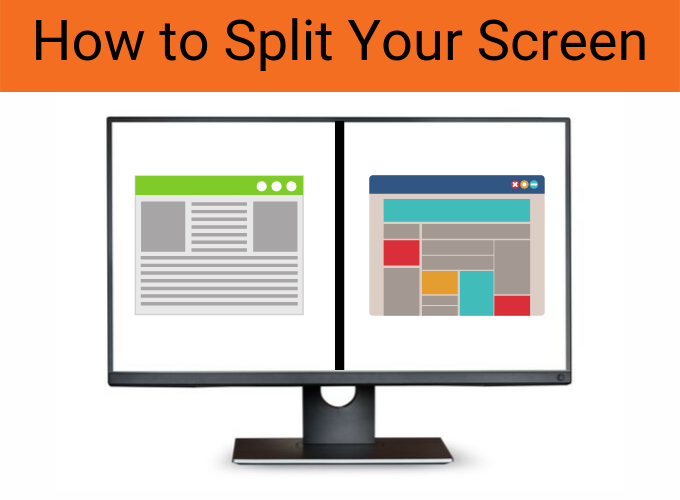
Windows 10 includes a number of default features that make splitting the screen as easy as dragging the display, simply more complex command can be achieved with third-political party applications.
This article will explore the diverse options available to you to divide one monitor and let you take full advantage of your screen existent estate.
Split Screen with Windows 10 Snap Help
Windows ten has a feature called "Snap Assist" that allows you to drag and drop a window to the role of the screen yous want to snap it to. Make certain this feature is enabled start.
- Click Start and open Settings.
- Click System and select the Multitasking tab.In that location is a slider chosen Snap Windows. Make sure it is set to On.
You also accept the option to choose certain options, such as:
- When I snap a window, automatically size it to fill available space.
- When I snap a window, prove what I can snap side by side to information technology.
- When I resize a snapped window, simultaneously resize any adjacent snapped window.
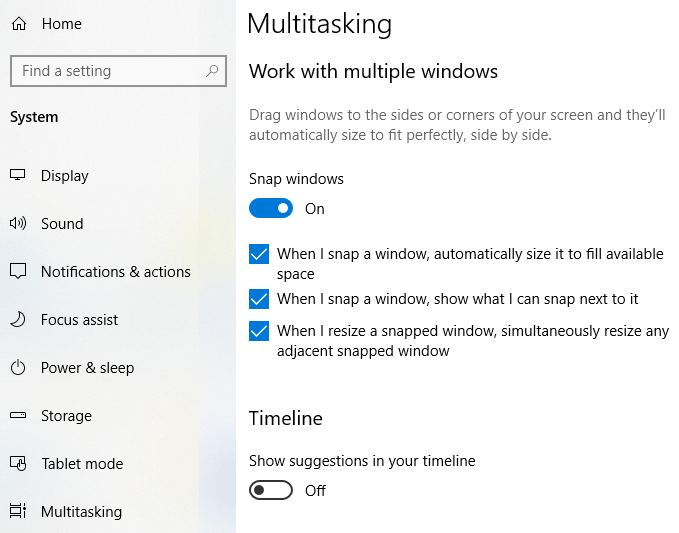
Once enabled, all you accept to do is click and drag a window to one side of the screen. Dragging information technology to the left of the screen will cause it to fill the left-side of the screen to the halfway point, while dragging it to the right will do the opposite.
If y'all drag a window to any of the 4 corners of the screen, the window volition snap to fill up a quadrant of the screen. Dragging it to the top of the screen volition make the window fill the unabridged screen. Once you have snapped a window into place, you can take hold of the dividing line between any two windows and adjust the size of each one.
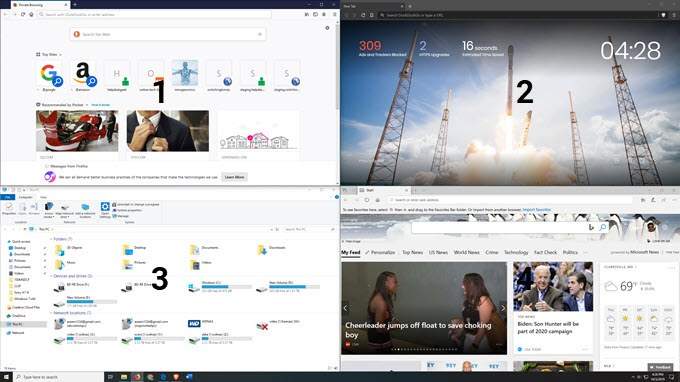
Two windows can be displayed split-screen, or iv tin exist displayed in a quadrant fix. One window can likewise be set up to fill half the screen while two others make full the acme and bottom of the other half of the screen. Withal, yous can't snap iii windows in a side-by-side-by-side layout, non without the help of a third-party application.
Split up Screen on Windows XP/seven/8
If you have an older version of Windows, y'all might not have access to the same built-in tools as Windows 10, and many of the freeware options won't work. Never fear, though: there are still ways to split the screen.
In Windows vii, open two applications. Once the two apps are open up, right-click on the taskbar and select "Show windows side by side." Voila: you'll have two windows open simultaneously. Information technology's as simple as that. And if you take a quick option at the screenshot beneath, you'll run across that you can also stack the windows on summit of one another.

Windows vii was the first iteration of the Windows Bone to back up the Snap Assist feature. It worked similarly to how Windows 10 currently implements the feature. But elevate an open window to either the left or the right side of the screen in the center and let it go. It will "snap" into place.
Windows 8 is a little more hard, but similar in function. Windows eight was designed with touchscreen devices in mind, but it can nevertheless be controlled via mouse. Open two apps, and identify one in full-screen style. If y'all utilize a touchscreen, swipe in from the left side of the screen until the app is docked.
If you take a mouse, place it in the top left corner, click and agree the app, and drag information technology into place on screen. A dividing line volition appear in the center of the screen when both apps are in place. Y'all can suit this line to change the amount of infinite each app takes up.
Split Screen with Freeware
If the born Windows 10 applications don't give you the control and utility y'all need, there are freeware applications y'all can use that grant access to more than avant-garde features. A few of these include WindowsGrid, GridMove, and AltDrag. The first two freeware applications we covered more extensively in a like mail service on this topic that explores how each 1 works.
The downside to freeware applications is that the developers brand nothing or side by side to aught for their development, then support for these programs tin end abruptly. For prolonged support for screen-splitting applications, consider a paid program that serves a similar purpose.
Paid Software Options
Paid split-screen software gives even more features than freeware and is more reliable in that you tin can trust support will keep as long equally people continue to buy the software. These programs also offer client back up to aid you navigate whatever technical difficulties you might run into.
Here are a few of the best options.
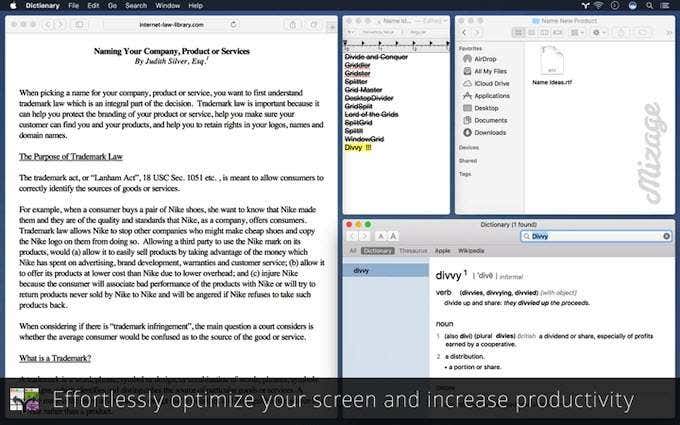
Divvy is a window management tool based around the thought of "divvying up" your windows into different sections. For just $xiv, the software is well within most budgets and allows users to split their screen into a variety of setups.
While it operates similarly to Windows Snap Assistance, users have more than options in how they suit their screens. Divvy makes information technology possible for users to create their own shortcuts to resize and reshape their screen yet they want.
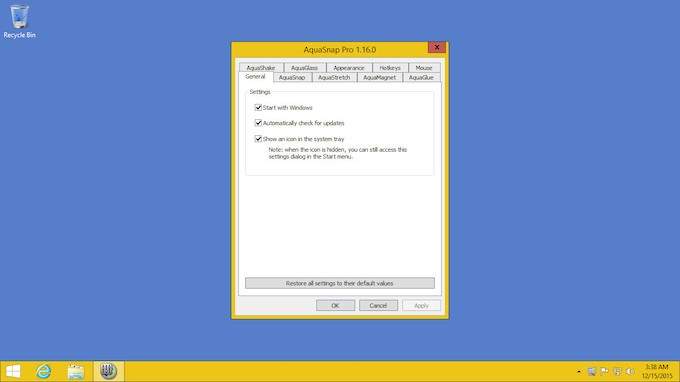
AquaSnap is similar to Divvy, except that it offers the software for gratis for personal use. The "Pro" version is $18. While less powerful than Divvy, it'south also more than user-friendly. AquaSnap doesn't accept every bit many features or as much control, merely the "Pro" version gives access to keyboard, mouse, and other types of shortcuts that brand resizing your screen equally easy as pressing a few buttons.
Y'all don't need an ultra-broad monitor to brand employ of any of these tools. Splitting the screen can be useful in any situation where you need to view multiple sources of information at once, but loftier-resolution displays are where screen-splits really shine through.
Do non share my Personal Information.
How To Split Screen On Hp Laptop Windows 10,
Source: https://www.online-tech-tips.com/computer-tips/how-to-split-your-laptop-or-pc-screenmonitor-in-windows-xp/
Posted by: saxontiontems.blogspot.com


0 Response to "How To Split Screen On Hp Laptop Windows 10"
Post a Comment